|
Grumman F4F-4 Wildcat
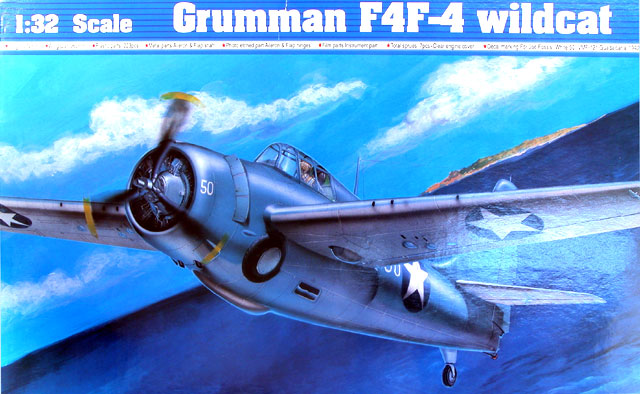
Trumpeter
S
u m m a r y
|
| Catalogue Number: |
02223 |
| Scale: |
1/32 |
| Contents and Media: |
223 parts in light grey and clear
injection molded plastic; metal shafts for ailerons and flaps; rubber
tires; photo-etched parts for control surface hinges; markings for one
aircraft |
| Price: |
USD$44.97
from Squadron.com (pre-orders) |
| Review Type: |
FirstLook |
| Advantages: |
Worthy subject in this large scale;
good quality moldings; adequate detail in most areas; ambitious workable
features including all control surfaces and wing folds; nicely detailed
cockpit parts; thin, clear and accurate transparent parts. |
| Disadvantages: |
Serious discrepancies of outline,
profile and details compared to published drawings, reference photos and
available kits; inaccurate "full floor" in shallow cockpit;
large number of recessed rivets on the wings; squared-off leading edge of rudder. |
| Recommendation: |
Only recommended if outline accuracy
is not an issue. |
Previewed
by
Brett Green

Trumpeter's 1/32
scale F4F-4 Wildcat will be available online from Squadron.com
Trumpeter's new 1/32 scale F4F-4 Wildcat comprises 223 injection
molded parts in grey plastic and clear styrene (including a clear cowl), rubber
tires, a small bag of metal rods, a photo-etched fret with hinges for control
surfaces and an acetate sheet with printed instruments.
Click the thumbnails below to view
larger images:
I was quite surprised by the large number of recessed rivets in
the wings. The remainder of the parts were more subdued in this respect, with
crisp, recessed detail on the fuselage halves.
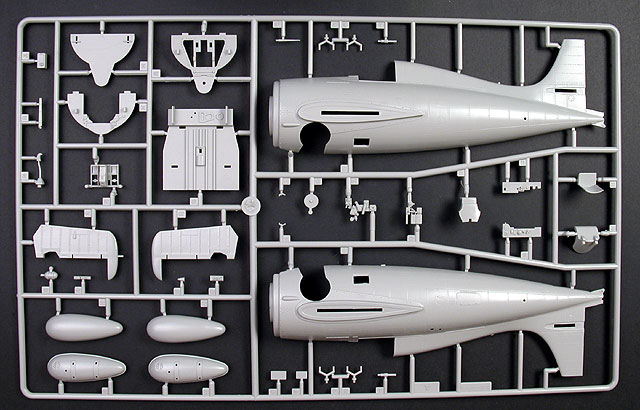
Click the thumbnails below to view
larger images:
Control surface textures are a little exaggerated though, with
prominent raised ribs on the elevators and peculiar, capsule-like shapes
representing fabric texture on the rudder. Light sanding will improve these
areas.
All control surfaces are movable, including the flaps. Each
control surface is connected using a metal rod and photo-etched hinges. It will
be interesting to see how these work in practice. Curiously, even though the
rudder is hinged, it is sharply squared off at the leading edge. Some
modification will be required.
The wings folds are also workable. These are hinged via a single
styrene pin inside the wing, so care will be required when handling the model
and operating the wing fold.
The cockpit shares the error of most other F4F kits, in that it
has a solid floor. In this large scale the problem will be more obvious.
However, the cockpit also contains some nicely detailed parts. Quadrants, boxes
and cases are all supplied separately so there is ample potential to complete a
superdetailed cockpit without a floor and with some scratchbuilt structural detail
added to
the lower half of the fuselage.
Detail in the engine is not bad, but we are presented with only
short intakes for the intercoolers. Adding wiring detail on the engine will be
worth the effort as it will be quite visible in
this scale.
The clear parts are really very good. They are thin and clear,
and the shape of the canopy parts is accurate.
Comparison to Drawings and Other Kits
Even while the kit was still on the sprues, something did not
look right when I examined the fuselage and canopy parts. This impression was
reinforced by diagrams in the instructions. At first I thought that the
windscreen angle was to steep, but I could not quite put my finger on the
source of the problem.
I decided to scale-up the 1/72 scale drawings in Bert Kinzey's
2000 edition of "F4F Wildcat in Detail" to both 1/48 scale and 1/32 scale.
Please note that I did not rely purely on the comparisons with a single set of
dramatically upscaled drawings. I also tested the important discrepancies by
checking photographs and the shape of other Wildcat models.
My conclusion is that there are serious discrepancies between
the drawings and some fundamental shapes on this model. Further comparison
with photos and the Tamiya 1/48 scale F4F-4 suggests that there are some real
problems with the outline of Trumpeter's kit. The diagram below indicates the
areas of discrepancy between the side profile drawing and the kit
fuselage/rudder:
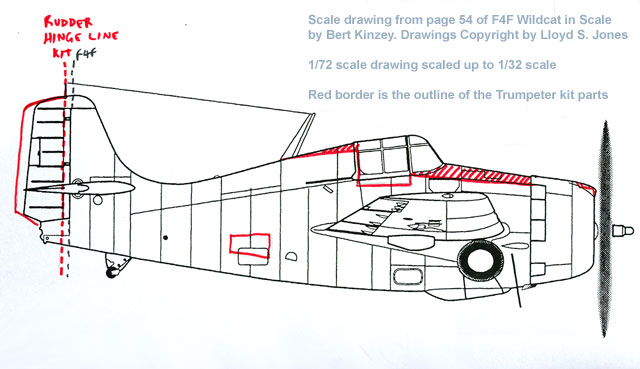
The main problems are:
-
The rudder hinge line is located
approximately 3mm too far aft. However, the rudder itself is close to the
correct size, and the leading edge of the fin is in the correct position. The
effect is that the vertical tail is noticeably too wide.
-
The access hatch is in the wrong
position and is the wrong shape
-
The fuselage spine should be almost
a straight line, but a noticeable downward curve has been added near the
canopy.
-
The nose is as much as 6mm too short
in height, and does not taper steeply enough to the engine cowling. As a
result of problems 3 and 4, the canopy line has been altered to suit these new
shapes. This means that the angle of the canopy, which should be angled upward
almost in line with the fuselage spine, is almost flat. Interestingly though,
the shapes of the windscreen and the sliding canopy section seem to be very
accurate. They just look odd because they will be mounted at the wrong angle.
-
The top cowl intake is squared off,
not angled forward as it should be.
-
In addition to these outline and dimensional problems, the
cuffs on the propeller blades appear to be proportionally too long. The
diameter of the propeller assembly is close to correct though.
The image below shows the actual Trumpeter fuselage laid over
the scaled-up plans:
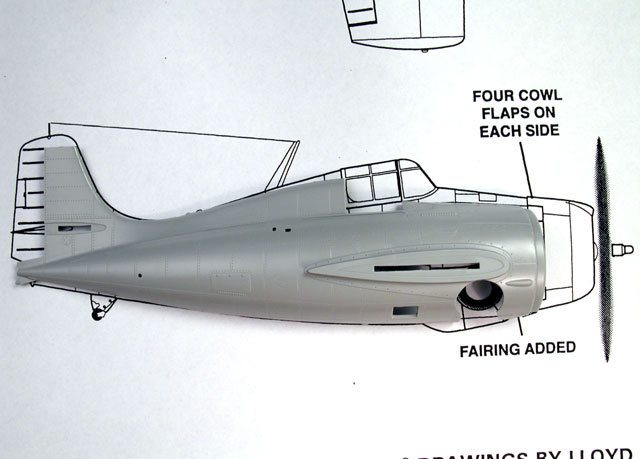
The wings are also too short in span by a total of around
10mm, although this is not as noticeable as the fuselage contours. However,
each aileron is also 5mm short. The shape of the wingtips is also wrong:
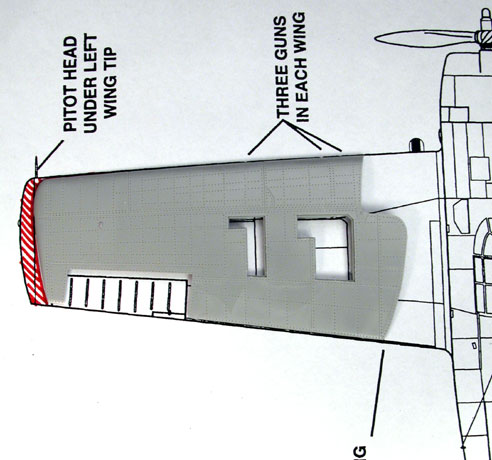
I compared the Tamiya 1/48 scale Wildcat fuselage to the 1/48
upscaled drawings. Conformance between the drawings and the Tamiya kit in the
areas of the fin, the fuselage hatch, fuselage spine and the nose was much
closer:
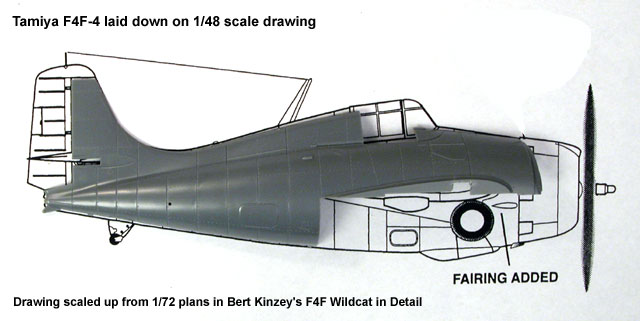
Trumpeter's 1/32 scale F4F-4 Wildcat qualifies as my biggest
disappointment in a plastic kit for many years.
Their USS Hornet, Mi-4, 1/48 scale MiG-15s; added to earlier
releases including the MiG-21 family and MiG-19s - not to mention their armour
kits - indicated that a new plastic star was rising in the East. Some of these
kits had specific problems, but other model companies make mistakes too, and
many of us expected to see steady improvement in subsequent releases.
Trumpeter's controversial 1/24 scale Mustang had a few profile
inaccuracies and some silly mistakes and tooling shortcuts, especially around
the nose, cockpit and the canopy. I am sure we all hoped this was just a hiccup.
However, this F4F-4 Wildcat is a poor omen for future large
scale Trumpeter WWII releases.
Trumpeter has the capability and the golden opportunity to
revive the segment of our hobby devoted to large-scale WWII model aircraft.
Hasegawa and Tamiya has already responded to their competition with each company
having recently released acclaimed WWII kits in 1/32 scale - Hasegawa's
marvelous (and relatively inexpensive) Bf 109G and Tamiya's breathtaking A6M5
Zero.
If Trumpeter wants to earn a reputation as a top-tier model
company along with Tamiya and Hasegawa, they will have to take a good hard look
at their initial research. As a modeler, it is extremely frustrating to see a
subject like the Wildcat, with so many restored examples available for
examination and abundant reference sources, botched so badly in fundamental
areas.
There is no doubt that Trumpeter is capable of producing a high
quality model kit. Some extra research time spent at the beginning of the
process, together with a post-tooling review, would improve the chances of
getting a high quality and accurate model kit.
So, after the analysis, does Trumpeter's kit look like a
Wildcat?
I suppose so, but it will be noticeably distorted in some key
areas. I do not consider myself a "rivet counter", and Trumpeter's F4F-4 is not
without merit. Even so, I cannot recommend it to modelers who want an accurate
kit straight from the box
I sincerely hope that it is not too late in the development
process to see a newly-tooled fuselage and rudder for the forthcoming Trumpeter
1/32 scale F4F-3 Wildcat.
Now that would be a commitment to quality!
Text and Images Copyright © 2003 by
Brett Green
Page Created 21 February, 2003
Last updated 15 August, 2003
Back to HyperScale Main Page
Back to Reviews Page
|
Home | What's
New | Features
| Gallery |
Reviews | Reference
| Forum
| Search